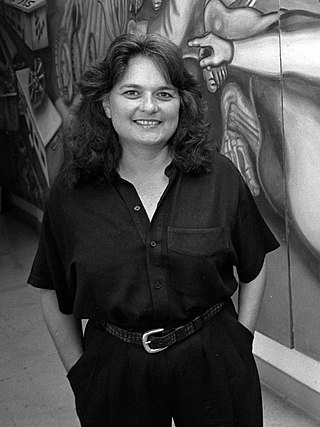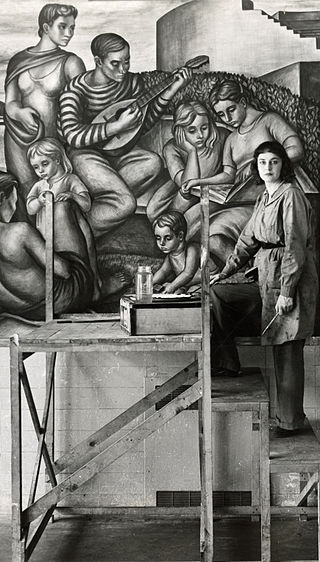Related Research Articles

Hoboken is a city in Hudson County in the U.S. state of New Jersey. Hoboken is part of the New York metropolitan area and is the site of Hoboken Terminal, a major transportation hub. As of the 2020 United States census, the city's population was 60,419, an increase of 10,414 (+20.8%) from the 2010 census count of 50,005, which in turn reflected an increase of 11,428 (+29.6%) from the 38,577 counted in the 2000 census. The Census Bureau's Population Estimates Program calculated that the city's population was 57,703 in 2022, ranking the city as the 688th-most-populous in the country. With more than 42,400 inhabitants per square mile (16,400/km2) in data from the 2010 census, Hoboken was ranked as the third-most densely populated municipality in the United States among cities with a population above 50,000. In the 2020 census, the city's population density climbed to more than 48,300 inhabitants per square mile (18,600/km2) of land, ranked fourth in the county behind Guttenberg, Union City and West New York.

Dorothea Lange was an American documentary photographer and photojournalist, best known for her Depression-era work for the Farm Security Administration (FSA). Lange's photographs influenced the development of documentary photography and humanized the consequences of the Great Depression.

Coit Tower is a 210-foot (64 m) tower in the Telegraph Hill neighborhood of San Francisco, California, overlooking the city and San Francisco Bay. The tower, in the city's Pioneer Park, was built between 1932 and 1933 using Lillie Hitchcock Coit's bequest to beautify the city of San Francisco. It was added to the National Register of Historic Places on January 29, 2008.

Dorothy Irene Height was an African American civil rights and women's rights activist. She focused on the issues of African American women, including unemployment, illiteracy, and voter awareness. Height is credited as the first leader in the civil rights movement to recognize inequality for women and African Americans as problems that should be considered as a whole. She was the president of the National Council of Negro Women for 40 years. Height's role in the "Big Six" civil rights movement was frequently ignored by the press due to sexism. In 1974, she was named to the National Commission for the Protection of Human Subjects of Biomedical and Behavioral Research, which published the Belmont Report, a bioethics report in response to the infamous "Tuskegee Syphilis Study.

The National Council of Negro Women, Inc. (NCNW) is a nonprofit organization founded in 1935 with the mission to advance the opportunities and the quality of life for African-American women, their families, and communities. Mary McLeod Bethune, the founder of NCNW, wanted to encourage the participation of Negro women in civic, political, economic and educational activities and institutions. The organization was considered as a clearing house for the dissemination of activities concerning women but wanted to work alongside a group that supported civil rights rather than go to actual protests. Women on the council fought more towards political and economic successes of black women to uplift them in society. NCNW fulfills this mission through research, advocacy, national and community-based services, and programs in the United States and Africa.

Barbara Smith is an American lesbian feminist and socialist who has played a significant role in Black feminism in the United States. Since the early 1970s, she has been active as a scholar, activist, critic, lecturer, author, and publisher of Black feminist thought. She has also taught at numerous colleges and universities for 25 years. Smith's essays, reviews, articles, short stories and literary criticism have appeared in a range of publications, including The New York Times Book Review, The Black Scholar, Ms., Gay Community News, The Guardian, The Village Voice, Conditions and The Nation. She has a twin sister, Beverly Smith, who is also a lesbian feminist activist and writer.
Byllye Yvonne Avery is an American health care activist. A proponent of reproductive justice, Avery has worked to develop healthcare services and education that address black women's mental and physical health stressors. She is best known as the founder of the National Black Women's Health Project, the first national organization to specialize in Black women's reproductive health issues. For her work with the NBWHP, she has received the MacArthur Foundation's Fellowship for Social Contribution and the Gustav O. Lienhard Award for the Advancement of Health Care from the Institute of Medicine of the National Academy of Sciences, among other awards.

Lady Pink, born Sandra Fabara (1964), is an Ecuadorian-American graffiti and mural artist.

Judith Francisca Baca is an American artist, activist, and professor of Chicano studies, world arts, and cultures based at the University of California, Los Angeles. She is the co-founder and artistic director of the Social and Public Art Resource Center (SPARC) in Venice, California. Baca is the director of the mural project that created the Great Wall of Los Angeles, which is the largest communal mural project in the world.
Maria Pepe was one of the first girls to play Little League baseball after Little League officially banned girls from participating in 1951.

Siti binti Saad was a pioneering Tanzanian musician in the taarab musical style. Through her music she was also an anti-colonial activist, feminist and Swahili cultural icon of 20th century. She produced over 250 phonograph records throughout her lifetime, becoming the first East African vocalist to release commercial recordings in the 1920s and 1930s. She also added a brand-new dance and pantomime component to taarab music called "natiki," which was inspired by Indian dance. She was a trailblazer as a female performer in the genre during a time when men artists controlled the industry. She performed in a variety of languages, but most significantly in Swahili, in contrast to earlier vocalists who solely sang in Arabic. She sang in cities of the coast of Tanganyika and Zanzibar.

Marion Greenwood was an American social realist artist who became popular starting in the 1920s and became renowned in both the United States and Mexico. She is most well known for her murals, but she also practiced easel painting, printmaking, and frescoes.
Dorothy Cotton was an American civil rights activist, who was a leader in the Civil Rights Movement in the United States and a member of the inner circle of one of its main organizations, the Southern Christian Leadership Conference (SCLC). As the SCLC's Educational Director, she was arguably the highest ranked female member of the organization.

The Hoboken Historical Museum, founded in 1986, is located in Hoboken, New Jersey and presents rotating exhibitions and activities related to the history, culture, architecture and historic landmarks of the city. In 2001, the museum moved to 1301 Hudson Street into the last standing building of the former Bethlehem Steel Hoboken Shipyard.
Juana Alicia is an American muralist, printmaker, educator, activist and, painter. She has been an educator for forty years. Juana Alicia, as part of the faculty Berkeley City College, founded and directed the True Colors Public Art program. Her sculptures and murals are principally located in the San Francisco Bay Area, Nicaragua, Mexico, Pennsylvania, and in many parts of California.
Mazola McKerson was the first of many things during her lifetime. In 1977 she was elected to the Ardmore City County Commission, making her not only the first African-American, but also the first woman to serve on the City Council. Only two years later, McKerson became the first African-American female mayor of Ardmore, Oklahoma, as well as the first woman in the United States to serve as mayor of a city of more than 30,000 people. McKerson was also the first chairperson of the Governor's Commission on the Status of Women. Aside from her public influence, McKerson owned and operated The Gourmet Restaurant in Ardmore from 1962 to 1997, the product of her home based catering company that she started in 1946.
Elmer Lucille Allen is a ceramic artist and chemist who graduated from Nazareth College in 1953. Both her father and brother were named Elmer and the family chose to name her Elmer Lucille. She became the first African-American chemist at Brown-Forman in 1966.

Dorothy Wagner Puccinelli, also known as Dorothy Puccinelli Cravath, was a New Deal-era artist and muralist. She was based in San Francisco, California.

Christia V. Daniels Adair was an African-American suffragist and civil rights worker based in Texas. There is a mural in Texas about her life, displayed in a county park which is named for her.
References
- 1 2 3 4 5 6 7 8 9 10 11 Foster, Robert; Metz, Holly, Interviewers (2006). "Club Zanzibar: Recollections of Dorothy McNeil" (PDF). Hoboken Museum.org. Vanishing Hoboken: The Hoboken Oral History Project. Hoboken Historical Museum and Friends of the Hoboken Public Library. Retrieved 21 April 2020.
{{cite web}}:|first2=has generic name (help)CS1 maint: multiple names: authors list (link) - ↑ Osmanski, Stephanie (15 November 2018). "DISTORT, Artist Behind New Hoboken Project, Talks Inspiration Behind Mural". hobokengirl.com. Archived from the original on 2020-09-25. Retrieved 21 April 2020.
- ↑ "Oral History Project". hobokenmuseum.org. Archived from the original on 2019-10-20. Retrieved 21 April 2020.
- ↑ "Chapbooks: Recollections of the People of Hoboken". hobokengirl.com. 4 April 2019. Archived from the original on 2019-04-04. Retrieved 21 April 2020.
- ↑ Metz, Holly. "Oral History Project: Vanishing Hoboken". hollymetz.net. Archived from the original on 2012-09-23. Retrieved 21 April 2020.
- ↑ Deering, Sally (8 April 2010). "Hudson Country Salutes Women of Achievement". RiverViewObserver.net. Archived from the original on 2017-08-25. Retrieved 21 April 2020.
- 1 2 3 hMAG (26 October 2018). "Hoboken Celebrates New Mural on Northern Edge, Celebrating Inspirational Women of the Mile Square City". hNOW Lifestyle Magazine. Archived from the original on 2019-02-17. Retrieved 21 April 2020.
- ↑ Zeitlinger, Ron (27 October 2018). "Massive mural pays tribute to three Hoboken heroes". nj.com. Archived from the original on 2019-05-12. Retrieved 21 April 2020.